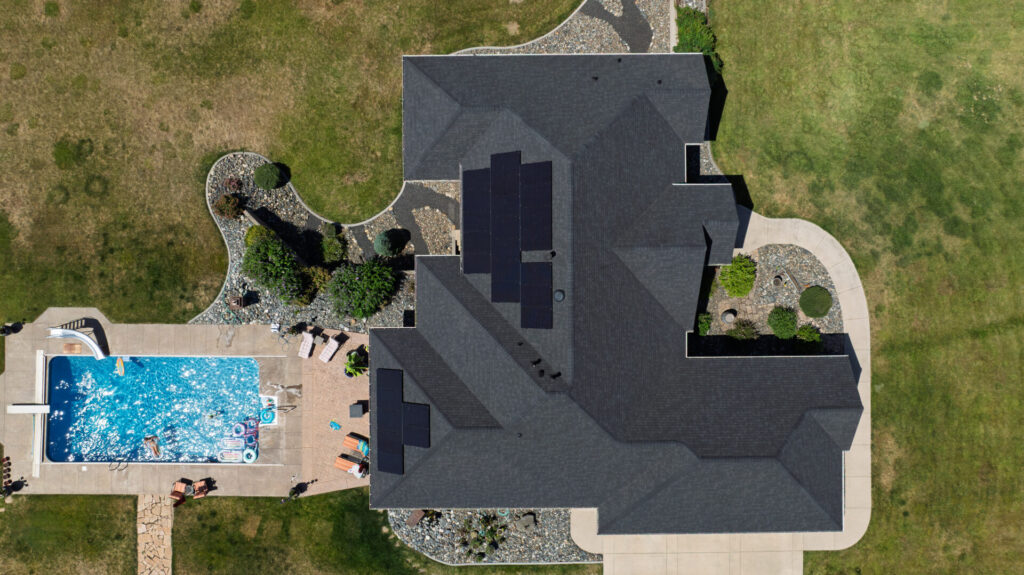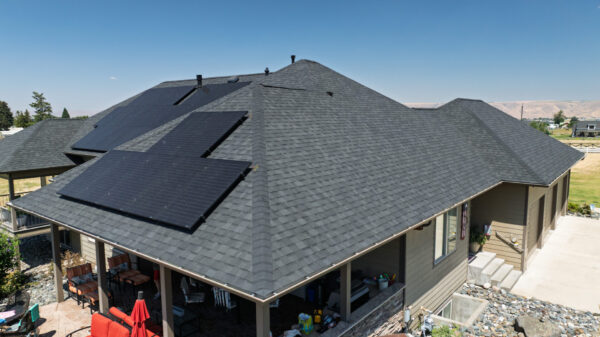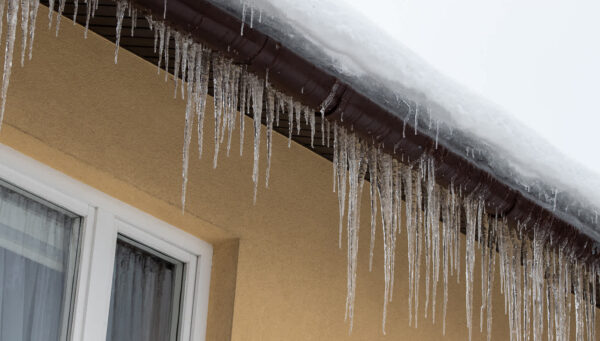Because solar panel systems last 20–30 years, panels must be installed on a roof that can handle the weight, exposure, and timeline. So, if you are wondering what roof is best for solar panels, it is essential to inspect the roof’s condition, age, and material type.
We’ll help you to understand:
- Which roofs are most compatible with solar?
- How to know if your current roof qualifies.
- What to consider before moving forward.
- How to evaluate different roofing materials for solar panel compatibility.
- The importance of roof orientation for maximizing solar energy production.
Is My Roof Ready for Solar?
A roof is considered solar-ready when it is strong, relatively new, and built from materials that allow secure installation. The type of roof and the underlying roof structure are crucial in determining if your home is good for solar, as different roof structures have varying load-bearing capacities and may affect the ability to safely install solar panels. But strength is not the only factor. A safe solar installation also depends on the remaining lifespan of the roof, the surface slope, and the amount of daily sunlight it receives.
Key points to review:
- Age: Roofs older than 15–20 years may not last through the life of the panels. Installing panels on an aging roof may lead to early removal and reinstallation costs.
- Slope: A pitch between 15–40° works best; south-facing planes capture more sun and deliver higher efficiency.
- Shade: Heavy shading from trees or nearby structures reduces panel output, and trimming or design changes may be needed.
- Material: Asphalt shingles and metal roofing are compatible. Different roof materials have varying compatibility with solar panels, and some materials, like clay tiles or wood shake, can complicate installation.
Before you install solar panels, consult a solar installer to assess the best roof options for your home and ensure your roof structure is suitable for supporting a solar system.
Think of it this way: would you place a brand-new solar system on a surface that may fail in five years? Condition and lifespan are critical.
In addition, if you’re considering a solar metal roof, remember that metal roof systems often outlast solar panels, giving homeowners long-term reliability. In addition, their reflective properties may reduce summer cooling costs while supporting solar output.

What Roof Is Best for Solar Panels?
When asking what roof is best for solar panels, most professionals point to two materials: asphalt shingles and metal. These surfaces balance durability, performance, and ease of installation. Selecting the best roof materials and the right roof type is crucial for ensuring your roof for solar panels is both compatible and long-lasting.
- Asphalt shingles are the most common roofing material and the most widely used, making them a common roofing material and often considered the best roof for solar panels due to their affordability, durability, and solar installer familiarity.
- Metal roofing provides unmatched longevity and is recognized as one of the best roof materials for solar installations, offering excellent compatibility with clamping systems.
- Other materials, such as tile, slate, or wood shake, are fragile and complex for solar installation.
Therefore, the two best choices for most homeowners are asphalt shingles and metal roofing. Choosing the most common roofing material or the best roof type can simplify the installation process and maximize solar benefits. However, let’s take a closer look at each type to gain a deeper understanding of why this is the case.
Asphalt Shingles and Solar Panels
Asphalt shingles cover most residential homes in the Inland Northwest, and they are also the most common base for solar systems. Composite shingles, a type of asphalt shingle, are widely used as the most common roofing material for solar installations due to their durability, affordability, and solar installer familiarity. Homeowners choose them because they are reliable, familiar, and adaptable to a wide range of climates.
Benefits:
- Contractors are highly familiar with installation methods.
- Standard mounting brackets fit easily without the need for complex tools.
- Repairs or replacements are straightforward and affordable.
Considerations:
- Older shingle roofs generally last 20–30 years, which may not outlast multiple solar panel cycles.
- If your asphalt roof is more than 15 years old, replacement may be smart before adding solar panels, as adding solar panels to an older asphalt roof may require roof replacement to avoid extra costs.
- Would you want to remove panels in five years just to replace the roof? That extra cost can be avoided by updating shingles first.
- Asphalt roofs can absorb heat, which may impact cooling costs and the efficiency of solar panels.
In addition:
- Asphalt shingles work well with Owens Corning™ underlayment, which improves protection under solar arrays.
- They provide a traditional look that blends with most neighborhoods, making solar panels less visually disruptive.
- Regular maintenance extends their service life, ensuring better value from both the roof and the solar system.
- Installing solar panels on asphalt roofs can help reduce energy bills by generating renewable energy.
Metal Roofing and Solar Panels
Metal roofing and solar panels create one of the most durable combinations available. A well-installed metal roof can last 40–70 years, which often outlives solar panels themselves.
Advantages:
- On standing seam roofs, no drilling holes are required—panels clamp directly to the seams, simplifying installation and reducing costs.
- Durability in snow and rain; snow slides off more easily.
- Energy efficiency from reflective coatings that keep homes cooler and help reduce energy costs.
Metal roofs with solar panels provide:
- Reduced risk of leaks during installation.
- Long service life that aligns with multiple solar panel lifespans, supporting a reliable solar setup.
- Lower maintenance needs, especially in areas with harsh weather.
However, the upfront cost of metal is higher than that of shingles. But for long-term solar use, a solar metal roof delivers unmatched performance. In regions like Spokane and Coeur d’Alene, where winters are harsh, the ability of snow to slide off metal roofing can directly improve solar efficiency.
Metal roofs also help keep your home cooler by reflecting sunlight, making them energy efficient and further benefiting your solar setup. Homeowners also appreciate that metal roofs are environmentally friendly, often made with recycled content and fully recyclable at the end of their service life. Pairing this sustainability with solar panels creates one of the most environmentally friendly solutions available.
 Installing Solar Panels on Residential Roofs
Installing Solar Panels on Residential Roofs
Residential installations differ from commercial solar projects. For a home, the roof’s design, slope, size, and roof orientation all influence how panels will perform. The best roof orientation for solar panels is typically south-facing in the Northern Hemisphere, as this maximizes sunlight exposure and solar output.
Important factors include:
- Square footage: The roof must have enough space for panels to be arranged efficiently. Larger roof planes without dormers or skylights typically allow for better layouts.
- Aesthetics: Many homeowners want panels to look balanced. Asphalt shingles and metal provide clean lines for installation.
- Slope: The angle of the roof matters. Steeper roofs may capture sunlight differently and require additional equipment.
- Ideal angle and optimal angle: Solar panels should be installed at an ideal angle, often close to your location’s latitude, typically between 30 and 45 degrees.
If you’re planning to install solar roof systems, the first step is assessing whether your roof has the space and strength to handle it. Contractors will also examine shading, structural integrity, and potential energy output. The size of your roof directly affects how much power your solar system can generate.
A professional solar installer will guide you through the installation process, ensuring the system is safely and efficiently set up for your specific roof type. Labor costs and installation costs can vary significantly depending on the complexity of your roof, the materials involved, and any special mounting requirements.
Factors That Make a Roof Solar-Ready
Not every roof is immediately ready for solar. Several conditions must be reviewed carefully, including checking for any structural damage that could affect the installation. Below are the most important factors explained in detail, and in some cases, a new roof may be required to ensure your roof is solar-ready.
Roof Material
The first factor is roof material. Asphalt shingles are the most common roofing materials and are widely supported by solar contractors. They allow racks and flashing to be installed with minimal complications and are considered one of the best materials for solar.
Metal roof and solar panels are also an excellent match. Standing seam metal, in particular, makes installation easier because solar clamps can attach directly to seams without penetrations.
Other materials, such as wood shakes, wood roofs, slate roofs, clay tiles, tile roof, concrete tiles, tar and gravel, gravel roofs, and flat roofs, each present unique challenges for solar installation. These different roofing materials can be fragile, heavy, or require specialized mounting techniques. For example, slate roofs and wood roofs are brittle and less compatible with solar panels, while clay tiles and concrete tiles are durable but heavy, often needing structural evaluation and experienced installers. Tar and gravel and gravel roofs work for solar panels but may require additional hardware to optimize panel angles, and flat roofs often need ballasted mounting systems tailored to the roof type.
Some homeowners may need to replace their current roof with a different material that is more suitable for solar panels, such as asphalt shingles or metal. These common roofing materials are preferred due to their compatibility, durability, and support for solar installations. Choosing the right roof materials and roof types is essential to ensure the longevity and efficiency of your solar system.
Age of the Roof
The age of the roof directly impacts solar readiness. Most older asphalt shingle roofs last 20–30 years, while metal systems can last 40–70 years. Solar panels typically perform for 20–30 years. If your roof has less than 10–15 years of life remaining, it is not wise to install panels yet.
Why? Because once the roof fails, the panels must be removed, stored, and reinstalled, adding unnecessary cost. For example, if you place solar on a 17-year-old shingle roof, you may be forced to replace the roof in just a few years, paying twice for labor. By updating the roof first, you avoid this extra expense and align both lifespans.
Structural Condition
Even if your roof is relatively new, its structural condition matters. The decking must be free of rot, and the framing must be able to handle additional weight. Panels, racking, and wiring add several pounds per square foot. While this may not sound like much, across an entire array, it becomes significant.
During a roof inspection, we’ll check for soft spots, sagging, water damage, and any signs of structural damage that could compromise the roof’s ability to support solar panels. If problems are found, they should be repaired before installation. Reinforcing framing or replacing damaged sheathing ensures the solar system has a stable foundation.
Remember: the cost of addressing issues now is always lower than removing panels later to fix hidden structural problems.
Orientation and Shade
The orientation of your roof affects how much sunlight panels can capture.
- South-facing planes are generally best in Idaho and Washington. A sloped roof can help achieve the best roof orientation for solar panels by allowing for optimal tilt angles.
- West-facing surfaces can also perform well, particularly for generating energy in the afternoon.
- East-facing roofs may be considered if shading is minimal.
Shade is another critical factor. Overhanging trees, nearby houses, or chimneys that block sunlight reduce efficiency. Installers often use software to map sunlight exposure across the year. This helps determine if a roof section is viable. Optimizing orientation and minimizing shade can make your solar system more energy efficient.
Evaluating Roof Space for Solar Panels
Evaluating your roof space is a critical first step when considering installing solar panels. The amount of usable roof area directly determines how many solar panels you can install and how much solar power you can generate for your home. As a general guideline, you’ll need about 100 square feet of roof space for every kilowatt of solar panels you plan to install.
To get started, measure your roof’s dimensions using a tape measure or a laser scanner. Be sure to account for any obstructions such as chimneys, vents, skylights, or dormers, as these can limit the available area for solar panel installation. The shape and orientation of your roof also play a significant role—south-facing roofs with a pitch of around 30 degrees are considered ideal for capturing the most sunlight throughout the day.
When it comes to roofing materials, asphalt shingles, metal roofs, and tile roofs are among the best roofing options to support solar panels. These materials provide a stable foundation for mounting systems and are commonly used in solar installations. Choosing the best roofing material for your home ensures that your solar panel system will be both efficient and long-lasting. By carefully evaluating your roof space and selecting the right roofing material, you’ll set the stage for a successful solar installation that maximizes your energy savings.
Severe Weather and Solar Panels
Severe weather can have a significant impact on your solar panel system, so it’s important to choose roofing materials that offer strong protection and durability. Metal roofs are especially well-suited for areas prone to heavy rain, hail, or high winds. Their robust construction and resistance to weather-related damage make them an excellent foundation for solar panel installation. Metal roofs can withstand severe weather events, helping to keep your solar panels secure and operational.
Asphalt shingles are another popular roofing material for solar panels. While they may be slightly more susceptible to damage from hail or heavy rain compared to metal roofs, they still provide a reliable surface for solar panel installation when properly maintained. The key to protecting your solar panel system in severe weather is ensuring that the mounting system is securely attached to the roof, minimizing the risk of panels being dislodged by strong winds.
Regular inspections and maintenance are essential for identifying and addressing any issues before they become major problems. By selecting the right roofing material and working with experienced solar installers, you can enjoy the benefits of solar power while minimizing the risks associated with severe weather. A well-chosen roof and a professional installation will help your solar panel system withstand the elements and deliver reliable energy for years to come.

Solar System Maintenance and Longevity
Maintaining your solar panel system is essential for maximizing energy production and ensuring a long service life. Regular cleaning of your solar panels helps remove dust, leaves, and debris that can block sunlight and reduce efficiency. It’s also important to inspect your system periodically for loose connections, damaged panels, or other issues that could affect performance.
Working with experienced solar installers can help you establish a maintenance schedule and quickly address any issues that arise. By choosing a durable roofing material and keeping up with regular maintenance, you can ensure that your solar panel system continues to deliver clean, reliable energy for decades. Proper care not only protects your investment but also maximizes your energy savings and the overall value of your solar installation.
Work With Russell Quality Roofing Before Going Solar
The roof is the foundation of every solar project. A weak roof may lead to future costs, but a strong one ensures decades of energy production. Working with a qualified solar installer is essential to ensure you have the right roof for solar panels, maximizing both compatibility and long-term durability.
We install Owens Corning asphalt shingles and standing seam metal roofs, the two roofing systems most often recommended for solar energy systems. With our experience, you can start solar on a roof built to last. Contact us today!
FAQs
Are there roof replacements that include solar?
We recommend installing separately, ensuring you are working closely with experts in each field. Most homeowners install asphalt or metal roofing first, then add panels separately.
How long should my roof last before I add solar?
Your roof should have at least 10–15 years of life left to avoid removing panels during replacement.
Can solar panels damage my roof?
When installed correctly with proper flashing, solar panels should not damage your roof and may even protect it.
AWARD WINNING PRODUCE
Order Online
Lorem ipsum dolor sit amet, consectetur adipiscing elit. Pellentesque vestibulum aliquam cursus. Mauris molestie aliquam urna. Curabitur nec eleifend risus. Integer eget libero sed elit pharetra ultricies eu in augue. Integer eget libero sed elit pharetra ultricies eu in augue.
BROWSE OUR ITEMS
